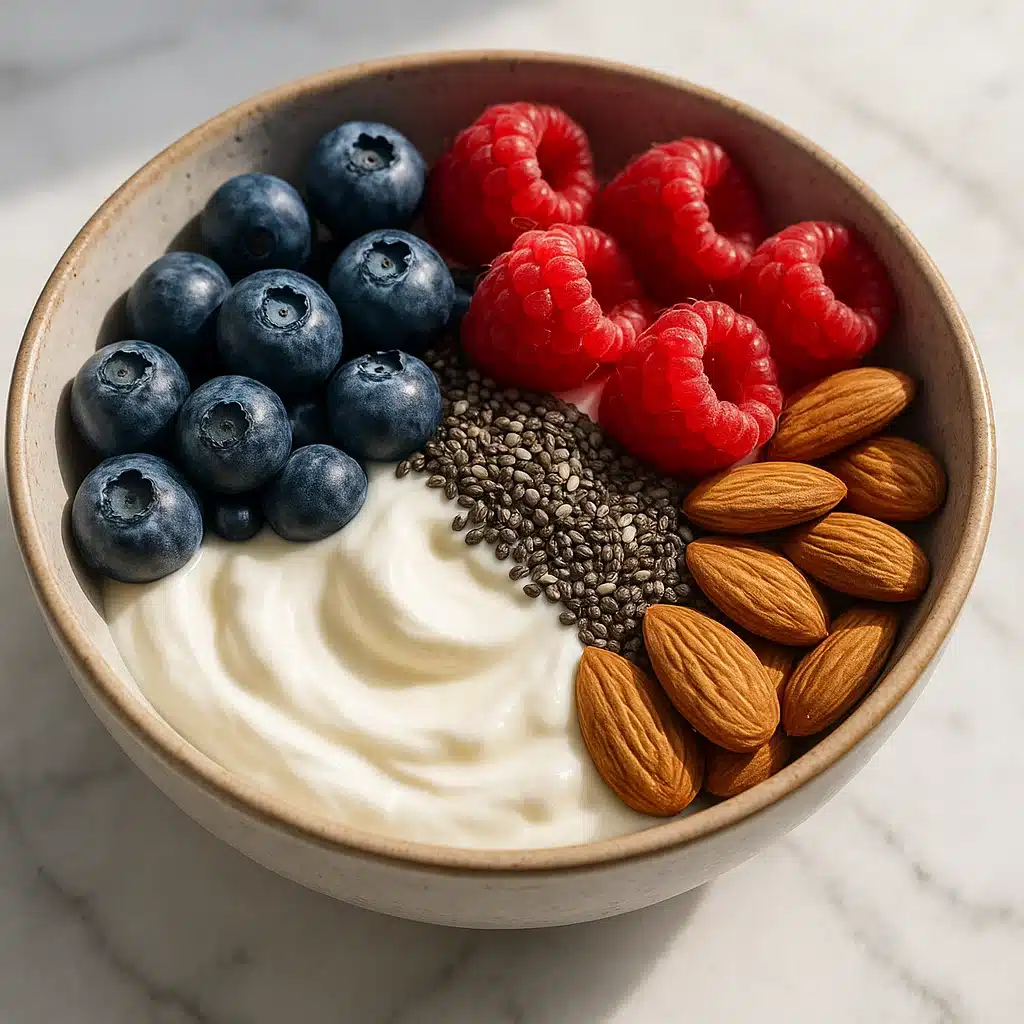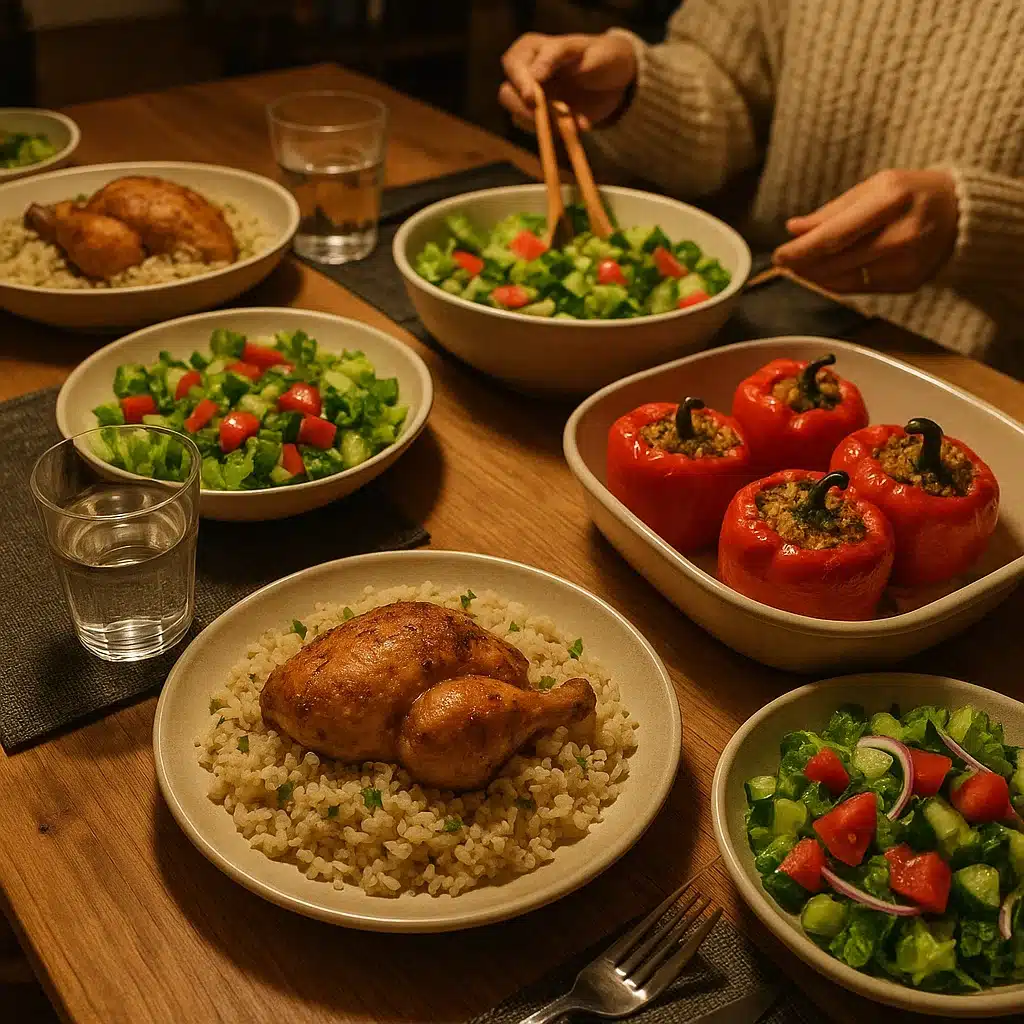In our increasingly busy world, finding lunch options that are simultaneously nutritious, satisfying, and convenient can feel like an impossible challenge. This roasted veggie couscous bowl was born from my own midday meal dilemmas—wanting something that would fuel my afternoon without requiring extensive preparation time or resulting in the dreaded post-lunch energy crash.
The inspiration for this roasted veggie couscous bowl comes from Mediterranean cuisine, where simple, fresh ingredients are transformed through thoughtful preparation into meals that nourish both body and spirit. The combination of fluffy couscous, caramelized roasted vegetables, and a bright, zesty dressing creates a harmonious balance of flavors and textures that feels both comforting and energizing.
What makes this roasted veggie couscous bowl particularly special is its remarkable versatility. The basic formula—grain + roasted vegetables + flavorful dressing—provides endless opportunities for customization based on seasonal produce, pantry ingredients, or personal preferences. It’s a template as much as a recipe, inviting you to make it your own while still delivering consistent satisfaction.
Whether you’re meal prepping for a busy work week, looking for plant-based lunch options, or simply wanting to incorporate more vegetables into your diet, this roasted veggie couscous bowl offers a delicious solution that proves healthy eating can be both convenient and crave-worthy.
Print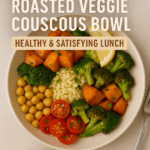
The Ultimate Roasted Veggie Couscous Bowl: Perfect Meal Prep Lunch
- Prep Time: 10 minutes
- Cook Time: 45 minutes
- Total Time: 55 minutes
- Yield: 8 1x
Description
This dish is proof that simple ingredients can create bold, layered flavor. Perfect as a side or a light main, it’s budget-friendly, nutritious, and totally satisfying.
Ingredients
4 Roma tomatoes
2 zucchini
1 bell pepper
1 red onion
4 cloves garlic (whole)
2 tablespoons olive oil
2 pinches salt and pepper
2 cups couscous*
3 cups vegetable broth
¼ bunch parsley
Instructions
-
Preheat oven to 400°F (200°C). Chop tomatoes, zucchini, bell pepper, and onion into 1–1.5 inch chunks. Peel garlic cloves and keep them whole.
-
Toss the vegetables and garlic with olive oil. Spread on a baking tray in a single layer and sprinkle with salt and pepper.
-
Roast for 45 minutes, stirring twice, until soft and slightly caramelized.
-
In the meantime, boil vegetable broth in a pot. Stir in couscous, cover, and remove from heat. Let steam for 10 minutes, then fluff with a fork.
-
Finely chop the roasted garlic and parsley.
-
Mix couscous, roasted veggies, and parsley in a large bowl. Adjust seasoning and serve warm or chilled.
Notes
Couscous comes in a variety of shapes and sizes, and you can use any type you prefer for this bowl. I opted for traditional couscous, which has a fine, delicate texture. Just be sure to check the instructions on your package, as different varieties may require slight adjustments to the cooking time or liquid ratio.
Nutrition
- Calories: 224
- Sodium: 462mg
- Fat: 4g
- Carbohydrates: 40g
- Fiber: 4g
- Protein: 7g
Table of Contents
Table of Contents
Why You’ll Love This Roasted Veggie Couscous Bowl Recipe
Perfect for Meal Preparation and Planning
In today’s fast-paced world, having ready-to-eat meals that maintain their quality over several days is invaluable. This roasted veggie couscous bowl was specifically designed with meal prep in mind—the flavors actually improve after a day in the refrigerator as the dressing permeates the ingredients. The components stay distinct without becoming soggy, and the dish tastes delicious whether served warm, at room temperature, or cold straight from the refrigerator. You can prepare a batch on Sunday and enjoy satisfying lunches throughout the week without additional cooking or assembly time. The recipe also scales easily, allowing you to prepare multiple portions with minimal additional effort.
Nutritionally Balanced for Sustained Energy
Unlike many quick lunch options that provide a temporary energy boost followed by an afternoon slump, this roasted veggie couscous bowl is specifically designed to deliver sustained energy through a balanced combination of complex carbohydrates, healthy fats, fiber, and plant-based nutrients. The couscous provides readily available energy while the fiber-rich vegetables and healthy fats from olive oil help regulate blood sugar release. This means you’ll feel satisfied and energized throughout the afternoon, rather than hungry or sluggish an hour after eating. The colorful variety of vegetables also ensures you’re getting a diverse array of phytonutrients and antioxidants to support overall health.
Remarkably Versatile and Adaptable
Few recipes offer the flexibility of this roasted veggie couscous bowl. You can easily substitute ingredients based on seasonal availability, dietary preferences, or simply what you have on hand. The basic formula works with virtually any combination of roasted vegetables—try sweet potatoes and Brussels sprouts in fall, asparagus and peas in spring, or eggplant and tomatoes in summer. The couscous can be replaced with quinoa, farro, or brown rice for different nutritional profiles or dietary needs. The dressing can be adjusted with different herbs, spices, or acid components like balsamic vinegar instead of lemon. This adaptability means you can enjoy variations of this dish year-round without getting bored.
Visually Appealing and Satisfying
We eat with our eyes first, and the vibrant colors of this roasted veggie couscous bowl make it as visually appealing as it is delicious. The combination of jewel-toned roasted vegetables against the neutral backdrop of couscous creates a meal that looks as good as it tastes. This visual appeal contributes significantly to meal satisfaction—research shows that colorful, attractive meals actually increase our perception of flavor and satiety. When you open your lunch container to reveal this colorful bowl, you’ll feel a sense of anticipation and satisfaction before taking your first bite.
Economical and Reduces Food Waste
This roasted veggie couscous bowl recipe is not only kind to your health but also to your budget. Couscous is an inexpensive grain, and the vegetable components can be adapted based on what’s affordable and in season. Even better, this bowl provides an excellent opportunity to use up vegetables that might be past their prime for raw consumption but are perfect for roasting. Those slightly soft bell peppers or zucchini that might otherwise be discarded can be transformed into delicious components of this meal. The flexible nature of the recipe means you can shop sales or use CSA box ingredients without compromising the final result.
Environmentally Conscious Choice
By centering your meal around plant-based ingredients and whole grains, you’re making a choice that’s beneficial not only for your health but also for the planet. Plant-forward meals like this roasted veggie couscous bowl generally have a lower carbon footprint than meat-heavy alternatives. Additionally, the meal prep aspect reduces the need for single-use packaging that often comes with takeout lunches, further minimizing environmental impact. Making conscious food choices like this one represents a small but meaningful step toward more sustainable eating habits.
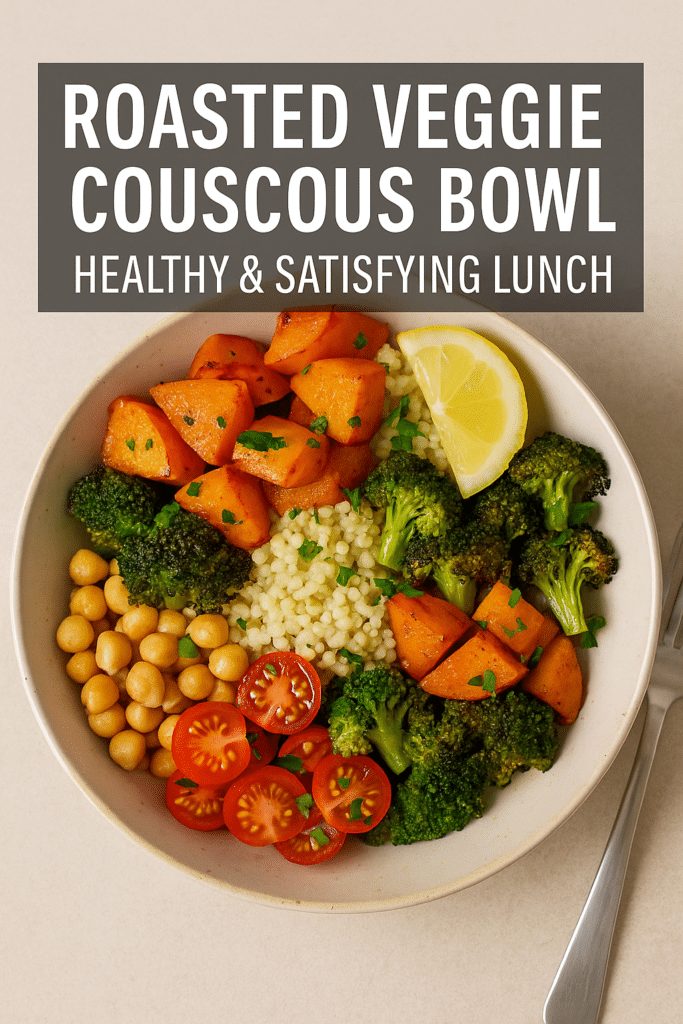
Nutritional Benefits of Key Ingredients in Your Roasted Veggie Couscous Bowl
Couscous: Quick-Cooking Grain with Surprising Benefits
While often mistaken for a grain, couscous is actually a tiny pasta made from semolina wheat. Despite this classification, it offers several nutritional advantages in your roasted veggie couscous bowl:
- Protein Content: Couscous contains approximately 6 grams of protein per cup of cooked product, making it a respectable plant-based protein source. While not complete on its own, when combined with vegetables and optional legumes in this bowl, it contributes to a meal with adequate protein content.
- Essential Minerals: Couscous provides meaningful amounts of selenium, an important antioxidant mineral that supports immune function and thyroid health. A one-cup serving offers about 35% of the daily recommended intake of selenium. It also contains smaller amounts of potassium, phosphorus, and magnesium.
- Energy-Providing Carbohydrates: The carbohydrates in couscous provide readily available energy, making it an excellent base for a midday meal. Whole wheat couscous, which can be substituted in this recipe, offers additional fiber benefits.
- Convenience Factor: While not a nutritional benefit per se, the extremely quick cooking time of couscous (5 minutes of passive time) makes it more likely that you’ll prepare a homemade meal rather than reaching for less nutritious convenience foods.
Colorful Bell Peppers: Vitamin C Powerhouses
Bell peppers, particularly red ones, offer exceptional nutritional value to your roasted veggie couscous bowl:
- Extraordinary Vitamin C Content: One medium red bell pepper contains over 150% of the daily recommended intake of vitamin C—more than twice the amount found in an orange. This vitamin is crucial for immune function, collagen production, and iron absorption.
- Carotenoid Antioxidants: The vibrant red color comes from carotenoids like beta-carotene, beta-cryptoxanthin, and lutein, which support eye health and may reduce the risk of certain chronic diseases. These compounds become more bioavailable when the peppers are cooked with olive oil, as in this recipe.
- Low Calorie, High Volume: Bell peppers add substantial volume, crunch, and flavor to the dish while contributing very few calories—about 30-40 calories per medium pepper. This helps create a satisfying meal without excessive energy density.
- Vitamin B6 and Folate: These B vitamins support energy metabolism and are particularly important for cognitive function during busy workdays.
Zucchini: Hydrating and Fiber-Rich
This versatile summer squash adds both nutrition and volume to your roasted veggie couscous bowl:
- High Water Content: Zucchini is approximately 95% water, making it a hydrating addition to your meal—particularly beneficial during busy workdays when water intake might be neglected.
- Significant Fiber Content: Despite its high water percentage, zucchini provides both soluble and insoluble fiber, supporting digestive health and contributing to the meal’s satiety factor.
- Potassium Source: Zucchini contains potassium, an electrolyte that helps maintain proper fluid balance and supports healthy blood pressure. This is particularly valuable in a lunch meal, as adequate potassium can help prevent the afternoon energy dip.
- Antioxidant Profile: Zucchini contains lutein and zeaxanthin, carotenoid antioxidants that are particularly beneficial for eye health—a consideration for those who spend long hours looking at screens.
Cherry Tomatoes: Lycopene-Rich Flavor Bombs
These small but mighty vegetables add both nutrition and bursts of flavor to your roasted veggie couscous bowl:
- Concentrated Lycopene: When roasted, tomatoes release lycopene, a powerful antioxidant associated with reduced risk of certain cancers and heart disease. The heating process makes this compound more bioavailable, and its absorption is enhanced by the olive oil in this recipe.
- Vitamin C and K: Cherry tomatoes provide vitamin C, supporting immune function, and vitamin K, which is essential for blood clotting and bone health.
- Natural Glutamates: Tomatoes contain natural glutamates that enhance the umami flavor of the entire dish, contributing to meal satisfaction without added sodium or artificial flavor enhancers.
- Balanced Acidity: The natural acidity of tomatoes brightens the overall flavor profile of the bowl, reducing the need for additional salt or heavy dressings.
Red Onions: Flavorful Prebiotic Source
Often used primarily for flavor, red onions actually offer significant health benefits to your roasted veggie couscous bowl:
- Prebiotic Fiber: Red onions contain inulin, a type of fiber that feeds beneficial gut bacteria. A healthy gut microbiome is increasingly linked to improved mood, immune function, and even cognitive performance.
- Quercetin Content: This flavonoid antioxidant, which gives red onions their distinctive color, has anti-inflammatory properties and may help reduce allergy symptoms.
- Sulfur Compounds: The sulfur-containing compounds in onions not only provide their characteristic flavor but also support detoxification processes in the body and may have cardiovascular benefits.
- Chromium: Red onions provide small amounts of chromium, a trace mineral that helps regulate blood sugar—contributing to stable energy levels throughout the afternoon.
Olive Oil: Heart-Healthy Fat Source
Both in the roasting process and the dressing, olive oil adds flavor and significant health benefits to your roasted veggie couscous bowl:
- Monounsaturated Fatty Acids: The predominant fat in olive oil is oleic acid, a monounsaturated fatty acid associated with reduced inflammation and improved heart health.
- Polyphenol Content: Extra virgin olive oil contains polyphenols with antioxidant properties that may help protect against oxidative damage and inflammation.
- Enhanced Nutrient Absorption: The fat in olive oil helps your body absorb fat-soluble vitamins and antioxidants from the vegetables in this dish, including vitamins A, D, E, and K, as well as carotenoids.
- Satiety Factor: The inclusion of healthy fats makes the meal more satisfying and helps prevent hunger from returning too quickly after lunch.
Roasted Veggie Couscous Bowl Ingredients and Their Roles
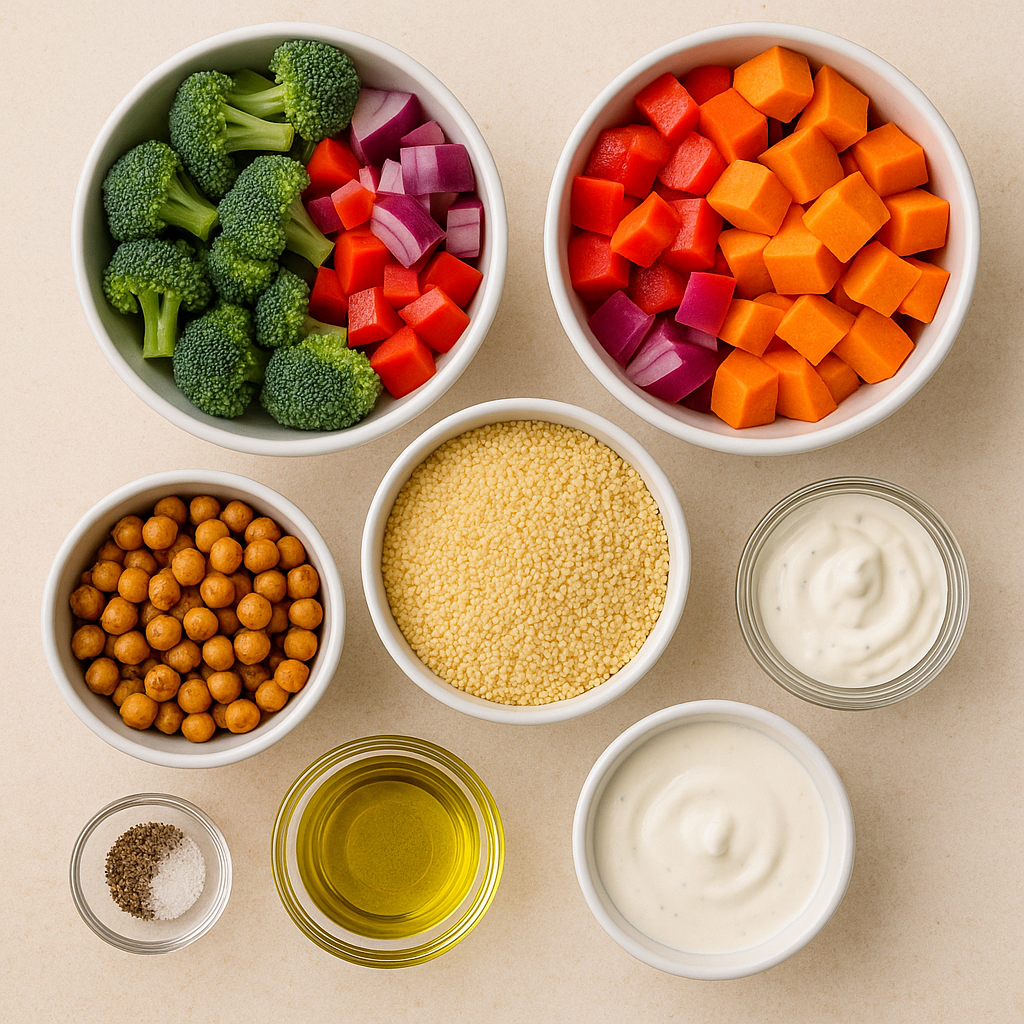
Core Ingredients
- 1 cup couscous: Forms the foundation of the bowl, providing carbohydrates for energy and a neutral base that absorbs the flavors of the other components. Regular couscous has a mild, slightly nutty flavor and cooks in just 5 minutes, making it ideal for quick meal preparation. Whole wheat couscous can be substituted for additional fiber content, though it has a slightly more pronounced flavor and sometimes requires a bit more liquid.
- 1 1/4 cups boiling water: The precise amount of liquid needed to properly hydrate the couscous without making it soggy or leaving it too dry. The boiling temperature is crucial for proper gelatinization of the starch in the couscous, resulting in the ideal fluffy texture. For additional flavor, vegetable or chicken broth can be substituted for some or all of the water.
- 1 zucchini, diced (about 1 1/2 cups): Adds volume, moisture, and nutrition to the roasted veggie couscous bowl. When roasted, zucchini develops a slightly sweet flavor and tender texture while maintaining enough structure to hold its shape in the finished dish. The size of the dice matters—aim for 1/2-inch pieces that will cook at the same rate as the other vegetables.
- 1 red bell pepper, chopped (about 1 cup): Contributes vibrant color, sweet flavor, and significant vitamin content to your roasted veggie couscous bowl. Red bell peppers become particularly sweet when roasted, developing caramelized edges that add complexity to the dish. Yellow or orange bell peppers can be substituted with similar results, while green bell peppers will provide a slightly more bitter, less sweet flavor profile.
- 1/2 red onion, sliced (about 3/4 cup): Provides aromatic depth and slight sharpness that balances the sweeter vegetables. When roasted, red onions develop a wonderful sweetness while maintaining their distinctive flavor. The slicing technique matters—cut the onion from pole to pole (rather than across the equator) for slices that hold their shape better during roasting.
- 1/2 cup cherry tomatoes, halved: Adds bursts of juicy flavor and bright acidity that lifts the entire roasted veggie couscous bowl. Halving the tomatoes allows them to release some moisture during roasting, concentrating their flavor while preventing them from becoming too dry. Different colored cherry tomatoes (yellow, orange, purple) can be used for additional visual appeal.
- 2 tablespoons olive oil (for roasting): Facilitates the caramelization of the vegetables, helps transfer heat evenly during roasting, and adds richness to the finished dish. Extra virgin olive oil provides the best flavor, though regular olive oil can be used if that’s what you have available. The oil also helps your body absorb the fat-soluble vitamins in the vegetables.
- Salt and pepper to taste: Essential for bringing out the natural flavors of all the other ingredients in your roasted veggie couscous bowl. Kosher salt or sea salt is preferable for its clean flavor. Freshly ground black pepper provides more complex flavor than pre-ground. About 1/2 teaspoon salt and 1/4 teaspoon pepper is a good starting point for this recipe.
- 1/2 teaspoon dried oregano: Adds an aromatic, Mediterranean flavor profile that complements the vegetables. Dried oregano works better than fresh in this application, as its flavor stands up well to the high roasting temperature. The herb also contains antioxidant compounds that add nutritional value beyond just flavor.
Dressing Ingredients for Your Roasted Veggie Couscous Bowl
- Juice of 1 lemon (about 2 tablespoons): Provides bright acidity that balances the richness of the olive oil and brings all the flavors into focus. Fresh lemon juice is strongly preferred over bottled for its vibrant flavor. The acid in the lemon juice also helps preserve the freshness of the dish when stored for meal prep.
- 1 tablespoon olive oil: Creates the base of the dressing, providing richness and helping the flavors adhere to the other ingredients. Use the best quality extra virgin olive oil you can afford for the dressing, as its flavor will be more prominent than the oil used for roasting.
- 1/2 teaspoon Dijon mustard: Acts as an emulsifier, helping the oil and lemon juice blend together rather than separate. It also adds a subtle complexity and slight pungency that enhances the overall flavor profile without making the dressing taste overtly mustardy.
- 1 teaspoon honey or maple syrup: Balances the acidity of the lemon juice with a touch of sweetness. Honey provides a floral quality, while maple syrup offers a deeper, slightly caramelized sweetness. This small amount of sweetener makes a significant difference in rounding out the flavor profile of the dressing.
- Salt and pepper to taste: Just as with the vegetables, proper seasoning is essential for the dressing. About 1/4 teaspoon salt and a pinch of pepper is typically sufficient, but adjust according to your taste preferences.
Optional Add-ins for Customizing Your Roasted Veggie Couscous Bowl
- 1/4 cup crumbled feta cheese: Adds creamy texture, saltiness, and protein. The tangy flavor of feta complements the sweet roasted vegetables beautifully. For a dairy-free version, firm tofu crumbled and marinated in lemon juice and herbs can provide a similar textural contrast.
- 1/2 cup chickpeas, rinsed and drained: Increases the protein and fiber content significantly, making the meal more substantial. Chickpeas also add a pleasant textural contrast to the softer vegetables and couscous. Roasting the chickpeas along with the vegetables adds crunch and deepens their flavor.
- 1/4 avocado, diced: Contributes healthy monounsaturated fats and a creamy texture that contrasts with the other components of your roasted veggie couscous bowl. The mild flavor of avocado also helps balance the acidity of the dressing and tomatoes. Add just before serving to prevent browning.
- 2 tablespoons toasted pine nuts or sliced almonds: Provides crunch, subtle flavor, and additional healthy fats. Toasting the nuts enhances their flavor significantly—this can be done in a dry skillet over medium heat for 3-5 minutes, stirring frequently to prevent burning.
- 1/4 cup fresh herbs (parsley, cilantro, or basil): Adds bright, fresh flavor and visual appeal as a finishing touch to your roasted veggie couscous bowl. Different herbs can dramatically change the flavor profile of the dish—parsley for a classic Mediterranean taste, cilantro for a more global flavor, or basil for an Italian-inspired variation.
How to Make Roasted Veggie Couscous Bowl: Step-by-Step Instructions
1. Preheat and Prepare (5 minutes)
Begin by positioning a rack in the middle of your oven and preheating to 425°F (220°C). This relatively high temperature is crucial for proper caramelization of the vegetables, which develops their natural sweetness and creates those delicious browned edges that add complexity to the dish.
While the oven preheats, line a large baking sheet with parchment paper or a silicone baking mat. This non-stick surface prevents the vegetables from sticking and makes cleanup significantly easier. If you don’t have either, you can lightly oil the baking sheet directly, though this may require more scrubbing afterward.
Gather and prepare all your ingredients before beginning the cooking process. This “mise en place” approach ensures smooth execution and proper timing throughout the recipe.
2. Prepare the Vegetables (10 minutes)
Wash all vegetables thoroughly under cool running water. For the zucchini, trim both ends and dice into approximately 1/2-inch pieces. Consistent size is more important than perfect cubes—the goal is pieces that will cook at the same rate.
For the bell pepper, remove the stem, seeds, and white ribs, then chop into pieces similar in size to the zucchini. The red onion should be peeled, halved, and then sliced into 1/4-inch thick pieces. For cherry tomatoes, simply wash and halve them.
Place all prepared vegetables in a large mixing bowl. Drizzle with the 2 tablespoons of olive oil, then sprinkle with the dried oregano, approximately 1/2 teaspoon salt, and 1/4 teaspoon freshly ground black pepper. Using clean hands or two large spoons, toss thoroughly until all vegetables are evenly coated with oil and seasonings. This even distribution ensures consistent roasting and flavor.
3. Roast the Vegetables (20 minutes)
Transfer the seasoned vegetables to your prepared baking sheet, spreading them out in a single layer with some space between pieces. Overcrowding the pan will cause the vegetables to steam rather than roast, preventing proper caramelization and resulting in a less flavorful roasted veggie couscous bowl.
If necessary, use two baking sheets to ensure adequate spacing. In this case, position oven racks in the upper and lower thirds of the oven and switch the pans’ positions halfway through roasting.
Place the baking sheet in the preheated oven and roast for approximately 20 minutes. The exact time may vary depending on your oven and the size of your vegetable pieces. The vegetables are done when they’re tender when pierced with a fork and have developed caramelized, golden-brown edges. The cherry tomatoes should be softened and slightly shriveled, releasing some of their juices.
There’s no need to stir or flip the vegetables during roasting unless you notice uneven browning in your oven. In that case, rotate the pan halfway through cooking time.
4. Prepare the Couscous (5 minutes)
While the vegetables are roasting, prepare the couscous for your roasted veggie couscous bowl. Place the dry couscous in a medium heatproof bowl. Add a pinch of salt (about 1/4 teaspoon) and stir briefly to distribute.
Bring the 1 1/4 cups of water to a full boil, either in a kettle or on the stovetop. Immediately pour the boiling water over the couscous. Give it a quick stir with a fork to ensure all the couscous is submerged, then cover the bowl tightly with a plate, lid, or plastic wrap.
Let the covered couscous sit undisturbed for exactly 5 minutes. During this time, the couscous will absorb the hot water and steam, hydrating and cooking to the perfect texture. Setting a timer is helpful to avoid over-soaking, which can result in mushy couscous.
After 5 minutes, remove the cover and fluff the couscous thoroughly with a fork. This separates the tiny granules and creates the light, fluffy texture that makes couscous so appealing. Be sure to fluff from the bottom of the bowl to break up any clumps that may have formed.
5. Make the Dressing (3 minutes)
While the couscous rests and the vegetables finish roasting, prepare the lemon herb dressing for your roasted veggie couscous bowl. In a small bowl or jar, combine the juice of 1 lemon, 1 tablespoon olive oil, 1/2 teaspoon Dijon mustard, and 1 teaspoon honey or maple syrup.
Add approximately 1/4 teaspoon salt and a pinch of freshly ground black pepper. Whisk vigorously until the mixture is well combined and slightly thickened, or shake in a sealed jar until emulsified. The mustard helps maintain this emulsion, preventing the oil and lemon juice from separating.
Taste the dressing and adjust seasonings if necessary. It should be tangy and bright, with a subtle sweetness and richness from the olive oil. Remember that the dressing will be distributed throughout the entire dish, so it should be slightly more intense than you might prefer on its own.
6. Assemble the Roasted Veggie Couscous Bowls (2 minutes)
Once all components are ready, it’s time to assemble your bowls. If serving immediately, divide the fluffy couscous between two bowls, creating a base layer. If preparing for meal prep, divide between storage containers with airtight lids.
Top the couscous with the roasted vegetables, distributing them evenly. The colorful mixture should be arranged to showcase the variety of vegetables.
Drizzle the prepared lemon dressing over the vegetables and couscous. Start with about half the dressing, then add more to taste. If preparing for meal prep, you may want to store some dressing separately to refresh the dish just before eating.
If using any optional add-ins like feta cheese, chickpeas, avocado, or nuts, add them now. Fresh herbs should be sprinkled on top as a final garnish.
Delicious Roasted Veggie Couscous Bowl Variations
Mediterranean-Inspired Version
Transform your basic roasted veggie couscous bowl into a Mediterranean feast with these modifications:
- Add 1/4 cup Kalamata olives, pitted and halved
- Include 1/4 cup crumbled feta cheese
- Add 2 tablespoons toasted pine nuts
- Use fresh oregano and parsley as your herbs
- Add 1/2 teaspoon za’atar seasoning to the vegetables before roasting
- Include 1/2 cup chickpeas for additional protein
- Garnish with a dollop of tzatziki or hummus
Moroccan-Spiced Variation
Give your roasted veggie couscous bowl a North African twist with these changes:
- Add 1/2 teaspoon each of ground cumin, coriander, and cinnamon to the vegetables before roasting
- Include 1/4 cup golden raisins or chopped dried apricots
- Add 2 tablespoons sliced almonds, lightly toasted
- Use preserved lemon in the dressing instead of fresh lemon juice
- Include 1/4 cup chopped fresh mint as a garnish
- Add a pinch of harissa paste to the dressing for heat
- Garnish with a dollop of yogurt mixed with a little harissa
Protein-Packed Option
Boost the protein content of your roasted veggie couscous bowl with these additions:
- Add 1/2 cup chickpeas, roasted alongside the vegetables
- Include 2 tablespoons hemp seeds sprinkled on top
- Add 1/4 cup edamame beans
- Top with a soft-boiled or poached egg
- For non-vegetarians, add 3 ounces of grilled chicken or salmon
- Use Greek yogurt as a creamy topping
- Replace regular couscous with protein-rich quinoa
Seasonal Adaptations
Adjust your roasted veggie couscous bowl based on seasonal availability:
Spring Version:
- Use asparagus, spring onions, and peas instead of zucchini and bell pepper
- Add fresh herbs like chives and dill
- Include lemon zest in the dressing
- Top with pea shoots or microgreens
Fall Version:
- Replace summer vegetables with diced butternut squash, Brussels sprouts, and red onion
- Add 1/2 teaspoon of warming spices like cinnamon or nutmeg
- Include dried cranberries for sweetness
- Use apple cider vinegar in place of some of the lemon juice
- Garnish with toasted pumpkin seeds
Storage and Make-Ahead Tips for Roasted Veggie Couscous Bowl
Optimal Storage Containers
For the best meal prep experience with your roasted veggie couscous bowl:
- Use glass containers with airtight lids for the best flavor preservation and to avoid any plastic taste transfer
- Compartmentalized containers work well if you want to keep certain elements separate until serving
- Mason jars create an attractive layered presentation if you place dressing on the bottom, followed by couscous, then vegetables, and toppings at the top
- Consider investing in containers specifically designed for salads, with separate dressing compartments
- Ensure containers are microwave-safe if you plan to reheat portions
Component Storage for Maximum Freshness
To maintain optimal texture and flavor throughout the week:
- Store the couscous and roasted vegetables together—they complement each other well even after several days
- Keep any fresh herbs, avocado, or crunchy toppings like nuts in separate containers and add just before serving
- If using feta cheese, you can store it mixed with the vegetables, but other cheeses might be better kept separate
- Store extra dressing in a small jar or container and add a fresh drizzle just before eating to revive flavors
- If including avocado, toss the diced pieces in a little extra lemon juice before storing to prevent browning
Reheating Guidelines
Your roasted veggie couscous bowl is delicious at various temperatures:
- Room temperature: For the best flavor, remove from the refrigerator 15-20 minutes before eating
- Warm: Microwave on 70% power for 1-2 minutes, stirring halfway through to ensure even heating
- Cold: Enjoy straight from the refrigerator as a refreshing option on hot days
- If reheating, add a small splash of water or broth to the couscous to refresh its texture
- Add any fresh components like herbs or avocado after reheating
Freezing Options
While best enjoyed fresh, portions can be frozen for later use:
- Freeze the couscous and roasted vegetables together in airtight containers for up to 2 months
- Do not freeze the dressing—make fresh when ready to serve
- Thaw overnight in the refrigerator for the best texture
- After thawing, refresh with additional dressing and fresh herbs
- Expect a slight texture change in the vegetables after freezing and thawing
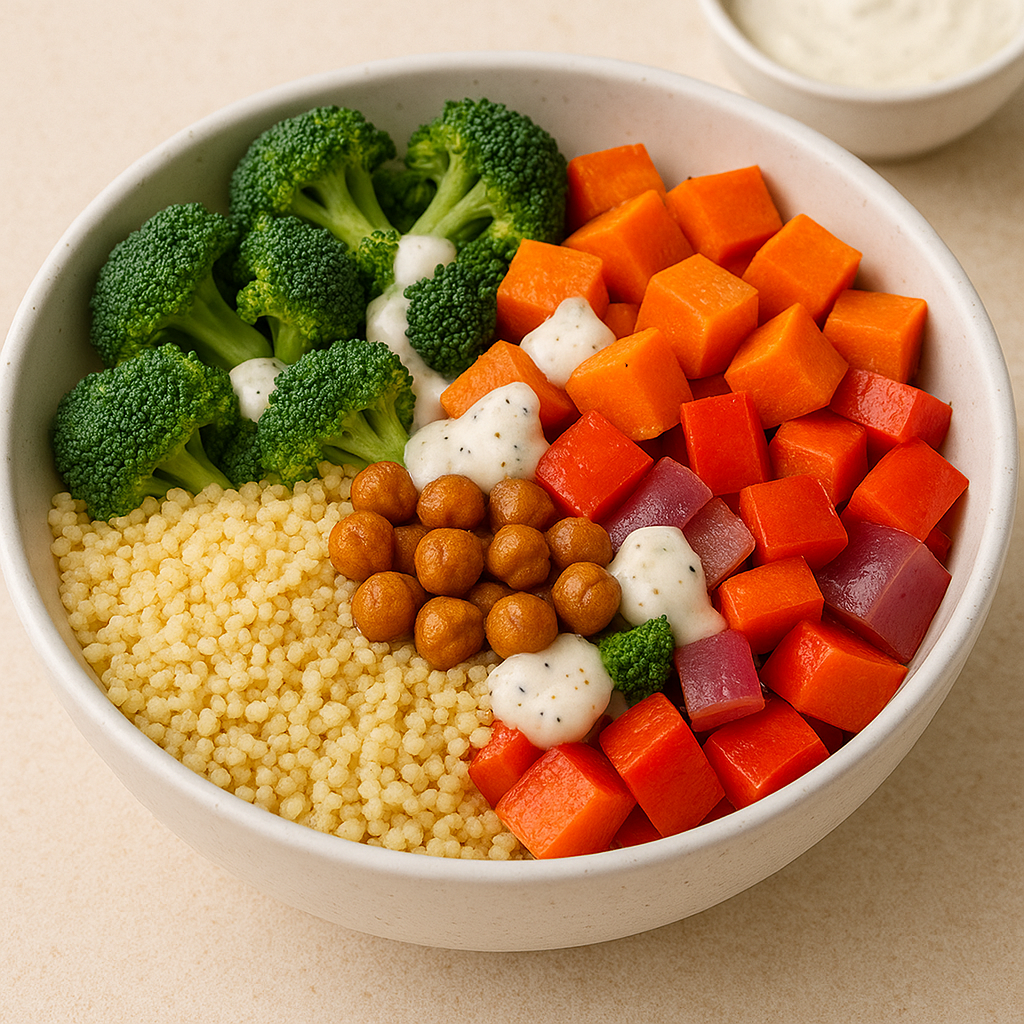
Frequently Asked Questions About Roasted Veggie Couscous Bowl
Can I use other grains instead of couscous?
Absolutely! This roasted veggie couscous bowl recipe works beautifully with various grain substitutions:
Quinoa: For a higher protein, gluten-free option, use the same volume of quinoa but increase cooking liquid to 2 cups and cooking time to about 15 minutes.
Bulgur Wheat: Another quick-cooking option with a nuttier flavor and more fiber. Use the same amount of boiling water but let it sit for about 15-20 minutes.
Farro or Barley: For a chewier texture with more fiber, though these require longer cooking times (about 30 minutes) and more liquid (about 3 cups per cup of grain).
Cauliflower Rice: For a low-carb version, use 2 cups of riced cauliflower sautéed in a tablespoon of olive oil for 5-7 minutes until tender.
Remember to adjust seasonings as needed, as some grains have stronger flavors than the mild couscous.
How can I make this recipe gluten-free?
To create a gluten-free version of this roasted veggie couscous bowl:
Replace the couscous (which contains wheat) with quinoa, rice, millet, or buckwheat
Ensure any added ingredients like mustard in the dressing are certified gluten-free
If using broth instead of water for cooking the grain, verify it’s gluten-free
For a grain-free option, use cauliflower rice as your base
Consider adding extra protein like chickpeas or nuts to compensate for the protein in wheat-based couscous
The roasted vegetables and dressing components are naturally gluten-free, so no modifications are needed there.
What’s the best way to prevent soggy vegetables?
For perfectly roasted, non-soggy vegetables in your roasted veggie couscous bowl:
Ensure vegetables are cut to similar sizes for even cooking
Don’t overcrowd the baking sheet—use two if necessary
Pat vegetables dry after washing to remove excess moisture
Roast at a high temperature (425°F/220°C) to quickly evaporate moisture
For especially watery vegetables like zucchini, consider salting them and letting them sit for 10 minutes, then patting dry before roasting
Allow vegetables to cool slightly before combining with couscous to prevent steam from creating sogginess
If meal prepping, store any particularly juicy components (like roasted tomatoes) on top rather than mixed throughout
Can I prepare this dish entirely in advance?
Yes, this roasted veggie couscous bowl is ideal for complete advance preparation:
The entire dish can be assembled up to 4 days in advance and stored in the refrigerator
For the freshest taste, store about 1/3 of the dressing separately and add just before serving
Add any fresh herbs, avocado, or crunchy toppings just before eating
The flavors actually improve after a day as they meld together
If preparing more than 4 days in advance, consider freezing portions without the dressing
For a week of lunches, you can prepare a large batch of vegetables and couscous on Sunday, then portion and customize individual containers with different add-ins for variety
How can I increase the protein content?
To boost the protein in your roasted veggie couscous bowl:
Add 1/2 cup chickpeas, white beans, or lentils (about 7-9g protein)
Include 1/4 cup crumbled feta cheese (about 4g protein)
Top with 2 tablespoons hemp seeds (about 6g protein)
Add a soft-boiled or poached egg (about 6g protein)
Include 1/4 cup edamame beans (about 8g protein)
For non-vegetarians, add 3 ounces of grilled chicken (about 25g protein) or salmon (about 22g protein)
Replace regular couscous with quinoa for an additional 2-3g protein per serving
Add 1/4 cup toasted nuts like almonds or pistachios (about 7-8g protein)
Serving Suggestions for Roasted Veggie Couscous Bowl
Perfect Pairings
Enhance your roasted veggie couscous bowl experience with these complementary items:
- Warm Pita Bread: Serve with a side of warm, lightly toasted pita bread for scooping up the couscous and vegetables.
- Simple Green Salad: A small side salad with just greens and a light vinaigrette provides a fresh contrast to the roasted elements.
- Soup Accompaniment: In cooler months, pair a smaller portion with a cup of tomato or lentil soup for a more substantial meal.
- Yogurt Sauce: Serve with a side of plain Greek yogurt mixed with a little lemon juice, garlic, and herbs as a cooling complement.
Presentation Ideas
Elevate your roasted veggie couscous bowl with these serving suggestions:
- Layer in Glass Jars: For meal prep or picnics, create attractive layers in mason jars with dressing on the bottom, couscous next, then vegetables and toppings.
- Composed Bowl: Rather than mixing all ingredients, arrange them in sections over the couscous for a “composed bowl” presentation that showcases each component.
- Garnish Thoughtfully: Add a final sprinkle of fresh herbs, a drizzle of good olive oil, or a dusting of sumac or za’atar for visual appeal and flavor enhancement.
- Edible Flowers: For special occasions, garnish with edible flowers like nasturtiums or pansies for a stunning presentation.
Beverage Pairings
Complete your meal with these complementary drinks:
- Sparkling Water with Citrus: The effervescence and subtle flavor complement the Mediterranean profile of the dish.
- Iced Herbal Tea: Mint or hibiscus tea provides refreshing contrast without overwhelming the flavors.
- White Wine: A crisp Sauvignon Blanc or Pinot Grigio pairs beautifully with the vegetable flavors for a more special occasion.
- Kombucha: The tangy, fermented notes complement the bright dressing and add probiotic benefits.
A Personal Note on Roasted Veggie Couscous Bowl
This roasted veggie couscous bowl recipe has become one of my most reliable allies in maintaining healthy eating habits despite a demanding schedule. What began as a simple solution to lunchtime dilemmas has evolved into a template that I return to season after season, adapting the components based on what’s available and what I’m craving.
I’ve found that having this colorful, nutritious meal waiting for me in the refrigerator provides not just physical nourishment but also a moment of mindful enjoyment in the middle of busy days. There’s something deeply satisfying about opening a container to reveal a thoughtfully prepared meal that I’ve made for myself—a small act of self-care amid daily demands.
The versatility of this dish means it never feels repetitive. Sometimes I lean into Mediterranean flavors with olives and feta; other times I explore Moroccan-inspired spice combinations or add protein for post-workout recovery. Each variation feels like a new discovery while maintaining the core benefits of convenience, nutrition, and satisfaction.
I encourage you to make this recipe your own. Experiment with different vegetables, grains, and seasonings. Pay attention to what combinations you find most satisfying and energizing. The beauty of home cooking lies in this personalization—creating meals that perfectly suit your tastes, needs, and lifestyle.
Nutritional Information for Roasted Veggie Couscous Bowl
Per serving (recipe makes 2 servings)
- Calories: 380
- Protein: 10g
- Fat: 14g
- Saturated Fat: 2g
- Unsaturated Fat: 12g
- Carbohydrates: 56g
- Fiber: 6g
- Sugars: 8g
- Sodium: 480mg
- Potassium: 520mg
- Vitamin A: 45% DV
- Vitamin C: 180% DV
- Calcium: 6% DV
- Iron: 15% DV
Note: Nutritional values are approximate and may vary based on specific ingredients used. Values do not include optional add-ins.
Related Recipes You’ll Love
- The Ultimate Turkey Club Pasta Salad: A Make-Ahead Lunch Revolution
- Tuna & White Bean Salad Wraps: A Protein-Packed Mediterranean Lunch
Have you tried this roasted veggie couscous bowl recipe? What variations did you create? Share your experience in the comments
Ready to take your meal planning journey to the next level? Join our thriving community of meal planning enthusiasts on Facebook where we share weekly templates, money-saving tips, and support each other’s meal planning goals. For visual inspiration, follow our Pinterest board featuring hundreds of organized meal prep ideas, time-saving kitchen hacks, and beautifully designed meal planning templates you can download and use immediately. Connect with us on social media and transform your meal planning experience today!

